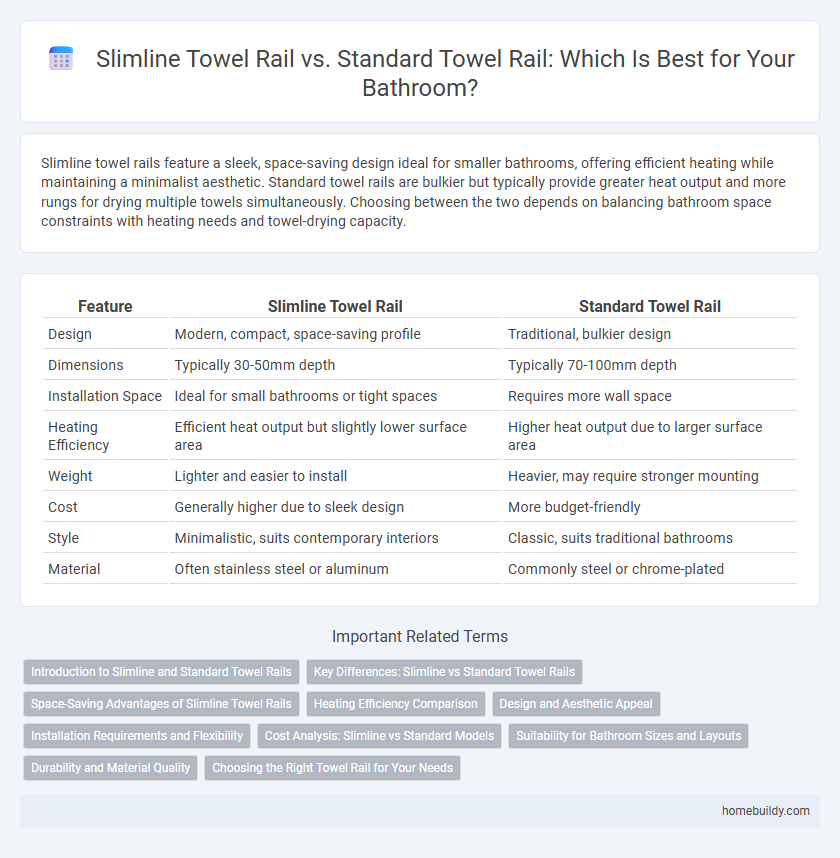Slimline towel rails feature a sleek, space-saving design ideal for smaller bathrooms, offering efficient heating while maintaining a minimalist aesthetic. Standard towel rails are bulkier but typically provide greater heat output and more rungs for drying multiple towels simultaneously. Choosing between the two depends on balancing bathroom space constraints with heating needs and towel-drying capacity.
Table of Comparison
| Feature | Slimline Towel Rail | Standard Towel Rail |
|---|---|---|
| Design | Modern, compact, space-saving profile | Traditional, bulkier design |
| Dimensions | Typically 30-50mm depth | Typically 70-100mm depth |
| Installation Space | Ideal for small bathrooms or tight spaces | Requires more wall space |
| Heating Efficiency | Efficient heat output but slightly lower surface area | Higher heat output due to larger surface area |
| Weight | Lighter and easier to install | Heavier, may require stronger mounting |
| Cost | Generally higher due to sleek design | More budget-friendly |
| Style | Minimalistic, suits contemporary interiors | Classic, suits traditional bathrooms |
| Material | Often stainless steel or aluminum | Commonly steel or chrome-plated |
Introduction to Slimline and Standard Towel Rails
Slimline towel rails offer a sleek, space-saving design ideal for compact bathrooms, featuring narrow profiles and modern aesthetics that efficiently warm towels without occupying much wall space. Standard towel rails, typically bulkier with wider bars, provide greater drying capacity and robust heat output, suitable for larger bathrooms seeking maximum functionality and comfort. Both types use electric or hydronic heating elements, but slimline models prioritize minimalism and energy efficiency while standard rails focus on performance and capacity.
Key Differences: Slimline vs Standard Towel Rails
Slimline towel rails feature a narrower profile and a sleek design, making them ideal for compact spaces and modern bathrooms, while standard towel rails are bulkier with traditional dimensions, offering more heating surface area. Slimline models typically consume less energy due to their reduced size yet may provide less heat output compared to standard towel rails, which excel at warming larger towels and rooms. Choosing between slimline and standard towel rails depends on balancing space constraints, heating requirements, and aesthetic preferences.
Space-Saving Advantages of Slimline Towel Rails
Slimline towel rails offer significant space-saving advantages compared to standard towel rails by featuring a narrower profile that fits seamlessly into compact bathrooms. Their streamlined design maximizes available wall space, allowing for easier installation in tight or awkward areas without compromising drying capacity. This makes slimline models ideal for optimizing small rooms while maintaining functionality and enhancing bathroom aesthetics.
Heating Efficiency Comparison
Slimline towel rails offer enhanced heating efficiency by utilizing advanced materials and a more compact design that maximizes heat distribution across the surface. Standard towel rails typically have bulkier profiles, which can result in slower heat-up times and less uniform warmth. Energy consumption for slimline models tends to be lower due to their optimized heating elements, making them a cost-effective choice for maintaining consistent towel warmth.
Design and Aesthetic Appeal
Slimline towel rails feature a sleek, minimalist design that enhances modern bathroom aesthetics by occupying less visual space and creating a streamlined appearance. Standard towel rails, typically bulkier with traditional profiles, can dominate a bathroom's design and detract from a contemporary look. The slimline option offers greater versatility in tight spaces, contributing to a cleaner, more elegant bathroom environment.
Installation Requirements and Flexibility
Slimline towel rails typically require less wall space and lighter mounting hardware, making them ideal for compact bathrooms or retrofit projects where wall structure limits installation options. Standard towel rails often demand more robust fittings and greater clearance, suitable for new builds or renovations with ample wall support. Slimline models offer enhanced installation flexibility by accommodating varying wall types, while standard rails provide sturdier heat output but with more restrictive placement requirements.
Cost Analysis: Slimline vs Standard Models
Slimline towel rails generally cost more upfront compared to standard models due to their sleek design and premium materials. However, they often consume less energy when electrically heated, leading to lower utility bills over time. Standard towel rails typically feature bulkier profiles with lower initial costs but may result in higher energy expenses depending on usage and size.
Suitability for Bathroom Sizes and Layouts
Slimline towel rails are ideal for small or narrow bathrooms where space is limited, offering a compact design that fits seamlessly without overcrowding. Standard towel rails suit larger bathrooms, providing greater heating capacity and multiple bar options for versatile towel storage. Selecting the right towel rail depends on bathroom size, layout, and heating requirements for optimal functionality and comfort.
Durability and Material Quality
Slimline towel rails are typically constructed from high-grade stainless steel or aluminum, enhancing corrosion resistance and longevity compared to standard towel rails made from lower-quality metals. The advanced material quality in slimline designs ensures sustained structural integrity under frequent use, reducing wear and the risk of rust. This superior durability makes slimline towel rails a preferred choice for both residential and commercial bathrooms seeking long-term performance.
Choosing the Right Towel Rail for Your Needs
Slimline towel rails offer a sleek, space-saving design ideal for compact bathrooms while maintaining efficient heating performance. Standard towel rails provide greater surface area for drying multiple towels simultaneously and often feature enhanced heat output for larger spaces. Selecting the right towel rail depends on room size, heating requirements, and aesthetic preferences, ensuring optimal functionality and style.
Slimline towel rail vs standard towel rail Infographic

 homebuildy.com
homebuildy.com